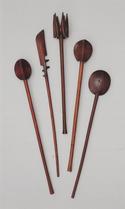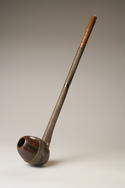Both of these staffs have additional features to which the carver has added four legs. The legs on the snuff container to the left and the bowl to the right appear to be generic allusions to animals.

Presumably to provide contrasting accents of colour, the carvers added burnished details probably using pieces of iron or assegais that were heated over burning coals before being pressed against the wood to scorch the surface.

It was fairly common for carvers to produce dance staffs with dual functions. The finial of the example at the centre of this group of five dance staffs consists of six small snuff boxes that appear to have been inspired by the form of a Gatling machine gun.
In the final stages of the 1879 Anglo-Zulu War the Gatling machine gun, which had six different compartments each with bullet-shaped stoppers, left a lasting impression on men fighting to maintain the independence of the Zulu Kingdom in the face of British Imperialist ambitions.

This dance staff, which appears to have doubled up as a snuff container, is unusual in that the snuff bowl was carved from two separate pieces of wood held together by finely executed wirework. The bowl presumably had a stopper that has since disappeared.
The staff has pokerwork detailing similar to that found on various items made by Tsonga-speaking carvers including carved spoons and vessels produced for both indigenous and external markets.